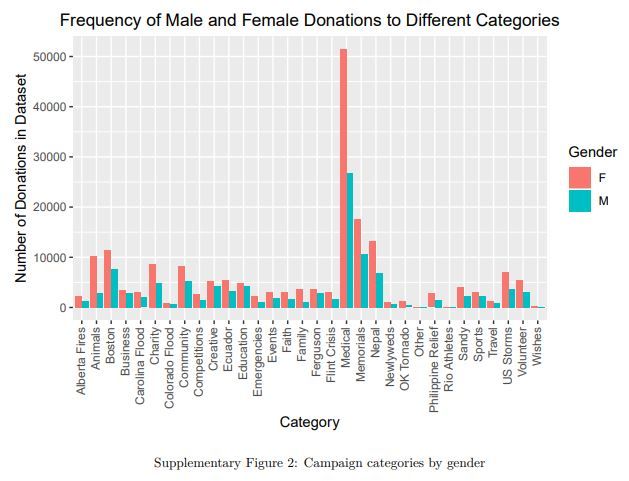Are men more helpful, altruistic, or chivalrous than women? Sometimes, maybe. But most social science evidence actually points in the opposite direction. Here are six sources of evidence suggesting women are, on average, the more helpful sex...
1) Evidence from Prosocial Behaviors
Girls and women are more likely to engage in prosocial behaviors than boys and men (Eisenberg & Fabes, 1998; Fabes & Eisenberg, 1998). Generally, these sex differences are small to moderate in size (expressed in d values, small sex differences are about +/- 0.20, moderate differences +/- 0.50, large differences +/- 0.80). Girls, for instance, are more kind/considerate than boys (d = -0.42), more comforting to others (d = -0.17), more helpful to others (d = -0.14), and are more likely to share or donate to others (d = -0.13).
Women also are significantly more likely than men to give to charities (whether to medical research, animals, storms, or charities), with sex difference not being due to background factors such as age and income (Piper & Schnepf, 2008; Sisco & Weber, 2019).

The same pattern holds when looking separately at single people and married/cohabiting people. For single people, 90% of women give more than the average man (Piper & Schnepf, 2008).
On the altruistic component of prosociality, the National Altruism Study (a nationally-representative sample of Americans in the 2002 General Social Survey) found sex is strongly associated with altruistic values, altruistic behaviors, and empathy, women best men's prosociality in almost every way.
Perhaps not unrelatedly, women and girls are primarily responsible for child-rearing in most cultures (Low, 1989). In an analysis of the Standard Cross-Cultural Sample (186 cultures selected to fairly represent preindustrial human cultures), Weisner et al. (1977) found mothers and their female relatives are responsible for most child-rearing, with fathers providing only about 6% of actual caregiving to children (see also Katz & Konner, 1981).
2) Evidence from Empathy, Emotional Intelligence, and Neuroscience
Most studies have found women are more empathetic than men (Baron-Cohen & Wheelwright, 2004; Eisenberg & Lenon, 1983; meta-analytic d = -0.27), though this depends somewhat on how empathy is measured (larger sex differences, d = -0.99, are found in self-reports).
In measures of the processing of facial expressions (in terms of discrimination, recognition, and identification), girls have a small advantage over boys, a sex difference that appears larger in infants (d = -0.92) than adolescents (d = -0.17; McClure, 2000). Women are especially better at quickly recognizing negative emotions, a difference that is not dependent on previous experience with child-rearing (Hampson et al., 2006).
There may be neurological differences in the ways men and women respond to empathic concerns (Christov-Moore et al., 2014; Schulte-Rüther et al., 2008; Soutschek et al., 2017). For instance, women appear to use more emotional brain areas, whereas men use more reflective brain areas, when engaging in empathy, emotion recognition, perspective taking, and affective responsiveness (Derntl et al., 2010). Neurological sex differences may exist in other areas of emotion regulation (Kret & De Gelder, 2012; McRae et al., 2008). Some researchers have failed to find sex differences in empathetic physiological responses, however (Michalska et al., 2013). Others have found genetic variants commonly associated with empathy and prosociality function differently in men and women (Christ et al., 2015).
3) Evidence from Personal Values, Character Strengths, and Moral Reasoning
Across all cultures women value benevolence (e.g., being very giving, seeking to help others, providing for general welfare) more than men do (Schwartz & Rubel, 2005), with the largest sex differences emerging in more gender egalitarian cultures (Schwartz & Rubel-Lifschitz, 2009). Schwartz and Rubel-Lifschitz think egalitarian cultures are where the “true” sex differences in benevolence and other values arise…"increased gender equality permits both sexes to pursue more freely the values they inherently care about more" (p. 171).
In a very large meta-analysis of 65 samples including more one million people, women tend to express higher levels of benevolence-related character strengths, such as kindness, love, and gratitude (Heintz et al., 2017). Sex differences in kindness were found across all cultures, being largest in the USA (d = −0.44) and smallest in Israel (d = −0.30). Sex differences in kindness were found across ages, too, being largest among children younger than 13 (d = −0.57) and smallest among 21-24 year olds (d = −0.05).
When reasoning about morality, women have higher Care Reasoning morality (i.e., maintaining relationships, caring for others is morality), men have higher Justice Reasoning (justice and equal treatment is morality; see Jaffee & Hyde, 2000).
4) Evidence from Vocational Interests and Career Choices
Women are more likely than men to choose people-helping professions (Lippa, 1998; Su et al., 2009). Large sex differences exist across such jobs as social work, psychology, teaching, nursing, and real estate (women more likely) versus mechanics, engineering, chemistry, welding, and computer programming (men more likely). As women have obtained higher status jobs over the last several decades, the degree to which a job is people-oriented has become a much more potent predictor of whether it is sex-differentiated (Lippa et al., 2014).
5) Evidence from Sociable (and Anti-Social) Personality Traits
Women are higher than men in agreeableness and other help-related personality traits across most cultures (Feingold, 1994), with (once again) the largest sex differences emerging more gender egalitarian cultures (Lippa, 2010; Schmitt et al., 2008).
Women also tend to score lower on anti-social “Dark Triad” personality traits, such as Machiavellianism (d = 0.27), Narcissism (d = 0.16), and psychopathy (d = 0.67; see Schmitt et al., 2016). In a study of 58 nations (Schmitt et al., 2016), the largest sex differences in Machiavellianism were found in relatively high gender egalitarian cultures of Iceland (d = 0.61), New Zealand (d = 0.60), Denmark (d = 0.55), and the Netherlands (d = 0.53).
6) Evidence from Economic Decision-Making
In economic games, results are more mixed when it comes to women being more altruistic (Baez et al., 2017). It seems men are chivalrous (selfless) only when it is to their strategic advantage to be so. Whereas women, on average, are altruistically egalitarian more consistently and most of the time (though sex differences are very small; Baez et al., 2017).
Also in economic games, women are more likely to be altruistic when forced to act intuitively and quickly, whereas when given the chance to reflect on their choices, women (particularly masculine women) tend to lower their levels of altruism (Rand et al., 2016).
When it comes to trust, however, men may be more trusting in economic decision-making, possible a result of women’s greater risk aversion (Chaudhuri & Gangadharn, 2003). Some studies find no sex differences in trust (Schwieren & Sutter, 2008). As with empathy, trust may activate different areas of men’s and women’s brains (Riedl et al., 2010).
Finally, in repeated-play "prisoner's dilemma" studies in which men and women are paired with partners and given a chance to cooperate (for mutual benefit) or defect (and benefit only themselves) across a series of games (it's actually more complicated than that, but you get the picture), a rather distinctive pattern replicates. Namely, men tend to cooperate pretty well with other men for their mutual benefit over time, whereas women paired with other women (or women and men paired together) tend not to cooperate effectively over time (Colman et al., 2018). A meta-analysis of sex differences in cooperation came to a similar conclusion, finding overall male–male interactions are more cooperative than female–female interactions (d = 0.16; Balliet et al., 2011).
7) Evidence from Experimentally-Tested Helping Behavior…not so fast, my friend
Women are not more likely than men to help in experimental tests, in fact the overall meta-analytic trend shows the opposite (Eagly & Crowley, 1986; meta-analytic d = 0.34). Women may help more in long-term measures of helping, but in experimental testing contexts men help more often when interacting with strangers (e.g., picking up hitchhikers and helping strangers in subways). Though in a large cross-cultural test of helping behavior involving 23 large cities around the world, there were no sex differences in actual helping strangers (e.g., by alerting a pedestrian who dropped a pen or assisting a blind person cross the street; Levine et al., 2001).
Women do tend to receive more help than men do in experimental tests (d = -0.46), especially when onlookers are around. Some have suggested that whereas truly altruistic prosocial behavior (often seen in women) is selflessly motivated, public prosocial behavior (exhibited by men when helping strangers) is more selfishly motivated (Carlo, 2006). In an experimental test of honesty, for instance, women (but not men) were less likely to be dishonest if it would hurt another person (and this was entirely due to women's higher levels of prosocial values; Grosch & Rau, 2017).
Conclusion
Overall, then, it appears women are more prosocial, are more empathetic and emotionally intelligent, value helping more, enter helping professions more, have more helping-related personality traits, and help more consistently in economic games. It generally takes more effort to get guys to be chivalrous or altruistic compared to women, outside of the help-a-stranger context. It seems only among strangers is chivalry not dead. Hey, jaywalker, look out for that car!
References
Andreoni, J., & Vesterlund, L. (2001). Which is the fair sex? Gender differences in altruism. Quarterly Journal of Economics, 116, 293-312.
Baez, S., Flichtentrei, D., Prats, M., Mastandueno, R., García, A.M., Cetkovich, M., et al. (2017). Men, women…who cares? A population-based study on sex differences and gender roles in empathy and moral cognition. PLoS ONE 12(6): e0179336. https://doi.org/10.1371/journal.pone.0179336
Balliet, D., Li, N. P., Macfarlan, S. J., & Van Vugt, M. (2011). Sex differences in cooperation: a meta-analytic review of social dilemmas. Psychological Bulletin, 137, 881-909.
Baron-Cohen, S., & Wheelwright, S. (2004). The empathy quotient: An investigation of adults with Asperger syndrome or high functioning autism, and normal sex differences. Journal of Autism and Developmental Disorders, 34, 163–175.
Barrett, L. F., Lane, R. D., Sechrest, L., & Schwartz, G. E. (2000). Sex differences in emotional awareness. Personality and Social Psychology Bulletin, 26, 1027-1035.
Carlo, G. (2006). Care-based and altruistically-based morality. In M. Killen & J. G. Smetana (Eds.), Handbook of moral development (pp. 551–579). Mahwah, NJ: Erlbaum.
Chaudhuri, A., & Gangadharn, L. (2003). Gender Differences in Trust and Reciprocity (No. 875). The University of Melbourne.
Christ, C. C., Carlo, G., & Stoltenberg, S. F. (2015). Oxytocin receptor (OXTR) single nucleotide polymorphisms indirectly predict prosocial behavior through perspective taking and empathic concern. Journal of Personality.
Christov-Moore, L., Simpson, E. A., Coudé, G., Grigaityte, K., Iacoboni, M., & Ferrari, P. F. (2014). Empathy: gender effects in brain and behavior. Neuroscience & Biobehavioral Reviews, 46, 604-627.
Colman, A.M., et al. (2018). Persistent cooperation and gender differences in repeated Prisoner's Dilemma games: Some things never change. Acta Psychologica, https://doi.org/10.1016/j.actpsy.2018.04.014.
De Bolle, M., De Fruyt, F., McCrae, R. R., Löckenhoff, C. E., Costa Jr, P. T., Aguilar-Vafaie, M. E., ... & Avdeyeva, T. V. (2015). The emergence of sex differences in personality traits in early adolescence: A cross-sectional, cross-cultural study. Journal of Personality and Social Psychology, 108, 171-185.
Derntl, B., Finkelmeyer, A., Eickhoff, S., Kellermann, T., Falkenberg, D. I., Schneider, F., & Habel, U. (2010). Multidimensional assessment of empathic abilities: Neural correlates and gender differences. Psychoneuroendocrinology, 35, 67-82.
Eagly, A. H., & Crowley, M. (1986). Gender and helping behavior: A meta-analytic review of the social psychological literature. Psychological Bulletin, 100, 283-308.
Eckel, C. C., & Grossman, P. J. (1998). Are women less selfish than men? Evidence from dictator experiments. The Economic Journal, 108, 726-735.
Eisenberg, N., & Fabes, R. A. (1998). Prosocial development. In W. Damon (Ed.), Handbook of Child Psychology, Fifth Edition (Vol 3: Social, Emotional, and Personality Development, N. Eisenberg [Ed.]).
Eisenberg, N., & Lennon, R. (1983). Sex differences in empathy and related capacities. Psychological Bulletin, 94, 100-131.
Fabes, R. A., & Eisenberg, N. (1998). Meta-analyses of age and sex differences in children’s and adolescents’ prosocial behavior. In W. Damon (Ed.), Handbook of Child Psychology, Fifth Edition (Vol 3: Social, Emotional, and Personality Development, N. Eisenberg [Ed.]).
Feingold, A. (1994). Gender differences in personality: A meta-analysis. Psychological Bulletin, 116, 429-456.
Grosch, K., & Rau, H. (2017). Gender differences in honesty: The role of social value orientation. Journal of Economic Psychology. https://doi.org/10.1016/j.joep.2017.07.008
Hampson, E., van Anders, S. M., & Mullin, L. I. (2006). A female advantage in the recognition of emotional facial expressions: Test of an evolutionary hypothesis. Evolution and Human Behavior, 27, 401-416.
Jaffee, S., & Hyde, J. S. (2000). Gender differences in moral orientation: a meta-analysis. Psychological Bulletin, 126, 703-726.
Katz, M. M., & Konner, M. J. (1981). The role of the father: An anthropological perspective. The role of the father in child development, 2, 155-185.
Kret, M. E., & De Gelder, B. (2012). A review on sex differences in processing emotional signals. Neuropsychologia, 50, 1211-1221.
Lennon, R., & Eisenberg, N. (1987). Gender and age differences in empathy and sympathy. Empathy and Its Development, 195-217.
Levine, R. V., Norenzayan, A., & Philbrick, K. (2001). Cross-cultural differences in helping strangers. Journal of Cross-Cultural Psychology, 32, 543-560.
Lippa, R. (1998). Gender-related individual differences and the structure of vocational interests: The importance of the people–things dimension. Journal of Personality and Social Psychology, 74, 996.
Lippa, R. A. (2010). Sex differences in personality traits and gender-related occupational preferences across 53 nations: Testing evolutionary and social-environmental theories. Archives of Sexual Behavior, 39, 619-636.
Lippa, R. A., Preston, K., & Penner, J. (2014). Women's Representation in 60 Occupations from 1972 to 2010: More Women in High-Status Jobs, Few Women in Things-Oriented Jobs. PloS one, 9, e95960.
Low, B. S. (1989). Cross-cultural patterns in the training of children: an evolutionary perspective. Journal of Comparative Psychology, 103, 311-319.
McClure, E. B. (2000). A meta-analytic review of sex differences in facial expression processing and their development in infants, children, and adolescents. Psychological Bulletin, 126, 424-453.
McRae, K., Ochsner, K. N., Mauss, I. B., Gabrieli, J. J., & Gross, J. J. (2008). Gender differences in emotion regulation: An fMRI study of cognitive reappraisal. Group Processes & Intergroup Relations, 11, 143-162.
Michalska, K. J., Kinzler, K. D., & Decety, J. (2013). Age-related sex differences in explicit measures of empathy do not predict brain responses across childhood and adolescence. Developmental Cognitive Neuroscience, 3, 22-32.
Piper, G., & Schnepf, S. V. (2008). Gender differences in charitable giving in Great Britain. Voluntas, 19, 103-124.
Rand, D. G., Brescoll, V., Everett, J. A., Capraro, V., & Barcelo, H. (2016). Social heuristics and social roles: Intuition favors altruism for women but not for men. Forthcoming in Journal of Experimental Psychology: General.
Riedl, R., Hubert, M., & Kenning, P. (2010). Are there neural gender differences in online trust? An fMRI study on the perceived trustworthiness of eBay offers. MIS Quarterly, 34, 397-428.
Schmitt, D.P., Alcalay, L., Allik, J., Alves, I.C.B., Anderson, C.A., Angelini, A.L., Asendorpf, J.B., et al. (2016). Psychological sex differences across cultures. Manuscript in preparation.
Schmitt, D. P., Realo, A., Voracek, M., & Allik, J. (2008). Why can't a man be more like a woman? Sex differences in Big Five personality traits across 55 cultures. Journal of Personality and Social Psychology, 94, 168-192.
Schwartz, S. H., & Rubel, T. (2005). Sex differences in value priorities: cross-cultural and multimethod studies. Journal of Personality and Social Psychology, 89, 1010-1028.
Schwartz, S. H., & Rubel-Lifschitz, T. (2009). Cross-national variation in the size of sex differences in values: effects of gender equality. Journal of Personality and Social Psychology, 97, 171-185.
Schulte-Rüther, M., Markowitsch, H. J., Shah, N. J., Fink, G. R., & Piefke, M. (2008). Gender differences in brain networks supporting empathy. Neuroimage, 42, 393-403.
Schwieren, C., & Sutter, M. (2008). Trust in cooperation or ability? An experimental study on gender differences. Economics Letters, 99, 494-497.
Sisco, M. R., & Weber, E. U. (2019). Examining charitable giving in real-world online donations. Nature Communications, 10(1), 1-8.
Smith, T. W. (2003). Altruism in contemporary America: A report from the National Altruism Study. Chicago, IL: National Opinion Research Center.
Soutschek, A. et al. (2017). The dopaminergic reward system underpins gender differences in social preferences. Nature Human Behaviour. doi:10.1038/s41562-017-0226-y
Su et al. (2009). Men and things, women and people: A meta-analysis of sex differences in interests. Psychological Bulletin, 135, 859-884.
Weisner, T. S., Gallimore, R., Bacon, M. K., Barry III, H., Bell, C., Novaes, S. C., ... & Koel, A. (1977). My brother's keeper: Child and sibling caretaking [and comments and reply]. Current Anthropology, 169-190.
Williams, J. H., Cameron, I. M., Ross, E., Braadbaart, L., & Waiter, G. D. (2016). Perceiving and expressing feelings through actions in relation to individual differences in empathic traits: The Action and Feelings Questionnaire (AFQ). Cognitive, Affective, & Behavioral Neuroscience, 16, 248-260.




